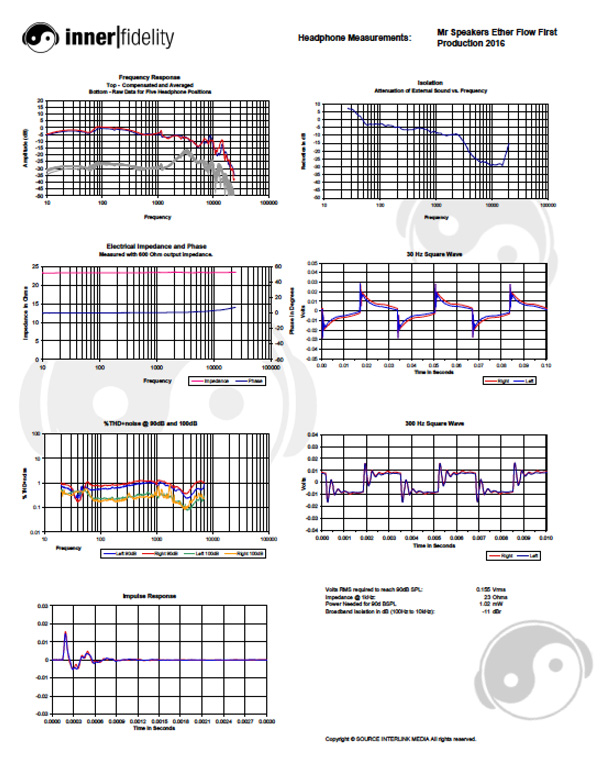| Columns Retired Columns & Blogs |
The Etherial Mr. Speakers Ether Flow Measurements

Click on graphs image to download .pdf for closer inspection.
Raw frequency response plots show the Ether Flow as fairly insensitive to movement of the headphones on the head. But I have to add that I did spend quite a bit of time when repositioning the headphones in order to get a good seal each time. I would say these headphones are fairly sensitive in the bass below the pad bounce at 60Hz to the quality of seal achieved.
Bass below 60Hz drops off about 4dB and then extends well. I'm not sure I heard the headphone this way; I don't hear any odd disjointedness that one might expect from this sort of measurement. Upper-bass emphasis appears to bleed into the midrange to about 400Hz. I did hear this but it didn't seem as bad as what the measurements might imply. I found the bass strong, but simultaneously bouncy and lithe.
The midrange suffers from too much emphasis from 200Hz to 400Hz, and then some lack of emphasis between 800Hz and 2kHz in the presence region. While I would say this is the biggest problem with the tonality of the Flow, I also think it gives the headphones an impression of space and may contribute to the very pleasant somewhat etherial quality in the listening experience.
Treble response from 2kHz and up is pretty much right on target, but the withdrawn presence region make the mid- and upper-treble seem just a little hot.
30Hz square wave response is a bit mishapen from the pad-bounce, and not as well extended as some other planar magnetic headphones.
300Hz square wave a bit too much ring after the leading edge transient, but it's a clean ring without raggedness, and there's very little subsequent noise. Waveform top is fairly flat indicating good treble balance.
Impulse response likewise has a bit too much ring, but is otherwise fairly smooth and noise-free.
Okay, now we get to the THD+noise. I've measured the pre-production Flow, and then two subsequent production units, and all of them had this strange curve that seems to have too little noise to be real. My guess is we're seeing some sort of noise here. My first guess was that as air moved back and forth through the layers of pads on the ear side, the pad would gently bump against each other creating a low-level noise. Dan and I talked about this and even tried a couple of experiments, which were inconclusive. The other thought I had was it might be the NiTanol headband wires ringing, but I damped them and found it didn't matter. My last thought is that there's some sort of interaction between my tast chamber and the sound coming out the back of these headphones. Anyway, I do occasionally see weird anomalies like this in the distortion measurements and it baffles me. Dan said his measurements are much more like Jude's measurements in this post. Bottom line: I don't hear these headphones as distorted at all; all I might be able to safely say is that the true distortion curves probably live below these lines shown.
Impedance plot is flat showing a 23 Ohm impedance with very litte features at all but for a slight roughness between 600Hz and 9kHz.
The Flow is an ostensibly open headphone, but isolation measurements show a modest -7dB reduction in outside noise from 60Hz to 2.5kHz. It seems the ear chamber itself is sealed and the various damping materials in front and behind the driver are providing some attenuation.
Needing 155mVrms to achieve 90dB at the ear, the Flow will only play moderately loud from a smartphone or portable device. Hook it up to a good amp...it's worth it.
- Log in or register to post comments




































